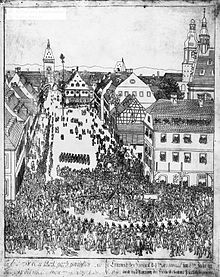Johannes Ruland (painter)


Johannes Ruland (born February 7, 1744 in Speyer ; † September 20, 1830 , ibid) was a German painter, draftsman and engraver .
Life
He was the son of the grocer Georg Heinrich Ruland (1708–1783) and his wife Anna Eva nee. King, daughter of a bell-maker. The grandfather, Johann Seger Ruland (1683–1745), also lived as a trader in Speyer and developed a new grape variety, which is named after him Ruländer .
Johannes Ruland attended grammar school at the Kaiserdom and showed an artistic talent at an early age. The father sent him in 1760 apprenticed to a court painter Philipp Heinrich Kiessling (1713 to 1767) in Durlach , including the Speyer advice him a scholarship granted. In 1766 he is mentioned as being back in his hometown.
In 1773 Ruland was granted citizenship of Speyer as a "painter" and in the same year married Anna Eleonora Seekatz, the daughter of the Worms painter Johann Ludwig Seekatz (1711–1783). He spent his old age with them as a widower and also died in Speyer. Anna Eleonora b. Seekatz died in 1782 and Johannes Ruland married Elisabeth Wilhelmine Schock, a tailor's daughter from Speyer. There were children from both marriages, with the sons Karl Friedrich (1784-1851) and Johann Gerhard (1785-1854) from the second marriage also working as painters.
Johannes Ruland died in Speyer in 1830, where he, a widower since 1829, lived in the house of his son Johann Gerhard. He was buried in the city's old cemetery .
plant
Ruland always operated the artistic activity as a sideline, while he lived mainly from the inherited groceries business. He left behind a large number of paintings, engravings, etchings and drawings, but very few of them have survived. Most widespread today are his drawings of historical buildings in the area, which he created more as fleeting sketches and not as finished works of art. Nevertheless, they are sought-after sources on the history of Speyer, the Palatinate and Rheinhessen . In the Speyer City Archives alone there are over 240 such sketches from Ruland's estate. One of his better-known engravings is the installation of the tree of freedom in Speyer in 1798, seen from the cathedral . Several of Ruland's oil paintings are in the possession of the Historisches Museum der Pfalz (Speyer) .
literature
- Fritz Klotz: The Speyer painter Johannes Ruland. In: Pfälzer Heimat , Palatinate Society for the Advancement of Science, Speyer, year 13, 1962, pp. 140–144
- Fritz Klotz: Speyer: Small town history. Historical Association of the Palatinate, Speyer district group, Pilger-Druckerei, Speyer 1971, p. 136
Individual evidence
- ^ Philipp Heinrich Kiesling in Stadtwiki Karlsruhe
- ^ Website with the aforementioned engraving by Johannes Ruland
| personal data | |
|---|---|
| SURNAME | Ruland, Johannes |
| BRIEF DESCRIPTION | German painter, draftsman and engraver |
| DATE OF BIRTH | February 7, 1744 |
| PLACE OF BIRTH | Speyer |
| DATE OF DEATH | September 20, 1830 |
| Place of death | Speyer |
